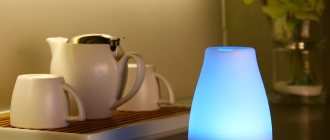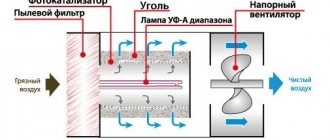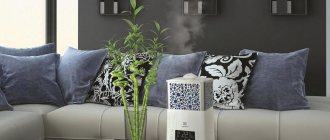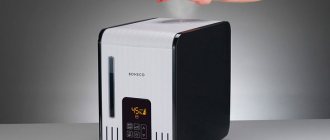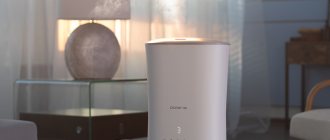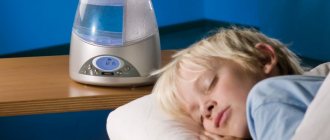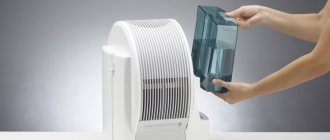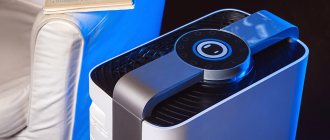The indoor air is saturated with harmful components that can cause many diseases in humans. In addition, in winter, the air in the room is dry, which also has a detrimental effect on the human body. Special equipment helps to cope with this task - humidifiers and air purifiers for enclosed spaces. Despite their small dimensions, these devices change the composition of the air to levels acceptable to the human body. Naturally, it is best to use these two devices at the same time, but if this is not possible, it is worth figuring out which is better: a humidifier or an air purifier in a particular case.
Device for purifying air masses
The purchase of budget Chinese air purifiers must be approached very carefully.
The main purpose of installing a purifier is to eliminate components from the air that are unsafe for humans. The purifier, passing air masses through itself, traps dust particles, hairs, sand, wool, mold spores, and waste products of mites. The main difference between the equipment is the installation of individual filtration. For a room where a large amount of dust accumulates, a cleaner with an electrostatic filter is suitable. In cases where it is necessary to remove an unpleasant odor, devices with a carbon filtration system are used. To completely break down solid particles, it is necessary to install a purifier with a photocatalytic filter, since other systems only capture and retain harmful components.
Humidifier or air purifier what to choose
Humidifiers are designed to create optimal humidity in an enclosed space. In accordance with GOST 30494-96, indoor humidity in cold weather should be no less than 40% and no more than 60%. When indoor air humidity is below 40%, a person becomes drowsy and chronically tired. When humidity levels drop below 30%, the human body is subject to stress. It rapidly loses natural moisture, which leads to a decrease in the immune system and, accordingly, to the occurrence of diseases.
Attention! According to statistics, in an apartment in winter, in which a humidifier is not installed, the humidity is only 25%.
Air purifiers are designed to trap particulate matter. Thanks to the installed filters, they are able to eliminate harmful components from air masses by more than 90%. Purifiers are typically installed more often in industrial environments where there are large amounts of particulate matter in the air.
Important! In order to understand whether it is necessary to adjust the humidity in the room or whether it is enough to just eliminate heavy air, you should measure the indicators using a hygrometer. It will accurately show the humidity levels in the room.
Advantages and disadvantages of air purifiers
It is quite difficult to characterize such a diverse segment of air purification systems. It would be fair to familiarize yourself in detail with each type of filtration, its operating principle and technical side. The summary of pros and cons applies to the general range of models and does not apply to specific types.
- high cleaning efficiency;
- relatively low cost of some replacement elements (for example, coarse filters are reusable, and carbon filters last from 3 months to 1 year);
- the ability to choose the most suitable model that meets individual needs;
- medium or low power consumption;
- among air purifiers there are both simple devices for easy cleaning and specialized devices for allergy sufferers and asthmatics.
- each filter has a narrow effective area of application; manufacturers have not yet developed universal ones;
- the cost of some devices and consumables is quite high;
- Not all devices can be used around the clock; some can oversaturate the air with ozone, while others can disrupt the natural microclimate.
Humidifier + purifier: universal devices
An integrated approach to improving the microclimate: a 2in1 device
It is impossible to compare these two devices in terms of efficiency, since they perform completely different functions: a purifier eliminates heavy particles harmful to the body, and a humidifier maintains an optimal level of humidity in the room for excellent well-being.
The most appropriate equipment option for individual use is 2in1 climate complexes, with the help of which harmful microparticles are eliminated and the required humidity is ensured. For example, the Smower Multi Action model. Such equipment is indispensable in rooms where there are children and allergy sufferers.
Humidifier with air purification function
Devices of this kind are a unique “combine” that combines two separate devices - a humidifier and an air purifier. Their feature is natural air humidification. The principle of their operation is to draw contaminated and dry air into the device using a built-in fan, where it is driven through special drums placed in water. Solid particles “stick” to the surface of the blades and are subsequently washed off into a special tray. And already purified and humidified air is supplied to the room.
Important! It is recommended to use a humidifier with an air purification function and the presence of a hydrostat, which controls the humidity in the room. This element will not allow excessive humidification of the air in the room.
Parameters to consider when choosing universal equipment:
- performance. For a room with an area of up to 20 m2, preference should be given to equipment with a capacity of 2 m3/min;
- size of the water tank. For a room of 40 m2, a 7 liter tank will be sufficient for high-quality humidification and cleansing;
- noise level, which should not exceed 40 dB;
- type of filtration system, installation of additional filters to eliminate unpleasant odors;
- additional functions such as shutdown when there is insufficient water, electronic control timer, ionizer.
Important! For finer purification of air masses and elimination of unpleasant odors, you will need a device that, in addition to the “hydrofiltration” system, is equipped with an additional filter. For example, the Philips HU4803 model affects air masses in 3 stages: trapping solid particles with a cartridge, removing bacteria and waste products from mites and viruses, and uniformly distributing air masses throughout the room.
Recommendations for choosing equipment
When considering what is better to choose – a washer or a household humidifier, you should listen to the recommendations of professionals.
The devices differ from each other in their operating features, range of functionality, and cost.
When comparing the functionality of a washer and an air humidifier, it is important to choose an option that will provide maximum comfort during operation of the device.
When choosing climate control equipment, you should decide on your personal needs, desired functions, and noise level.
When purchasing a washer or humidifier, it makes sense to take into account a number of useful recommendations:
When choosing a sink model, you should not expect that the humidity will be uniform in several rooms. However, when installing a powerful device in a corridor or hall, the results of its impact will be felt in adjacent rooms. When choosing a humidifier, the presence of ionization will be a serious plus when purchasing. This function is practically never found in sinks. When purchasing humidifiers, users often consider it as a mobile device that will be used in one room or another.
It is important to take into account that long-term operation of equipment in one room creates an imbalance. It involves over-humidifying one room and over-drying another. When purchasing climate control equipment, it is important to consider the complexity of maintenance
In this regard, sinks occupy a leading position, since they require tireless control of the amount of liquid and cleaning of the plates. The ease of maintenance of a humidifier depends on the specific model.
When choosing between a washer and a humidifier, it is important to consider various criteria. Professionals recommend washing because it provides natural humidification and uniform air distribution in the room.
Professionals recommend washing because it provides natural humidification and uniform distribution of air in the room.
Air purifier with humidification function: features of the filtration system
The devices should be easy to use and maintain.
The type of filtration system, namely the installed filter, determines which harmful particles the device will rid the room of. The filter can be:
- electrostatic, in which several metal plates with a statistical field are used. Polluted air masses passing between them settle. Filters of this type clean the air from dust;
- HEPA filter, which cleans the room of dust by 99.9%;
- photocatalytic, which eliminates bacteria, viruses and gases;
- coal, which allows you to eliminate volatile harmful components from the air, for example, tobacco smoke.
A humidifier can be installed in the purifiers:
- traditional, in which contaminated air masses pass through an installed wet filter;
- ultrasonic, in which air masses pass through small sprays obtained by splitting water.
If you feel decreased performance, dry mouth and nose, and drowsiness, then you should think about installing a humidifier indoors. For families with growing children or people with allergies to dust or other components, it is worth paying attention to an air purifier. For more enterprising people, today there are models of combined devices that allow you to simultaneously purify and humidify the air masses in the room.
Air purifiers - a new level of comfort
The advantage of air purifiers is the wide selection of different modifications and configurations. Depending on individual needs, the user can choose the most suitable model without overpaying for unnecessary options.
The whole variety is divided by types of filter elements and additional options:
- photocatalytic systems;
- primary filters;
- carbon filters;
- HEPA filters;
- UV disinfection lamps;
- built-in ionizers;
- plasma or electrostatic filters.
Each type of filter system is also divided into subtypes. The variety of air purifiers is not limited by strict standards; there are models of different configurations on sale - here you just need to highlight priorities.
Without going into a detailed description of the features of the filter elements, we can conditionally divide them according to the principle of operation:
- removal of large mechanical contaminants;
- fight against viruses, fungal spores, microbes and other bacteria;
- neutralization of gases, odors, fumes of building materials or household chemicals, formaldehyde, soot, and other impurities characteristic of urban air;
- effective cleaning of animal hair and plant pollen;
- high-quality air purification from all types of dust of any size.
Thus, the combination of several filters will ensure maximum efficiency and remove up to 99.9% of harmful impurities and allergens. This type of technology is suitable for all users, without exception, the main thing is to choose the right model.


